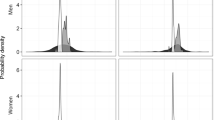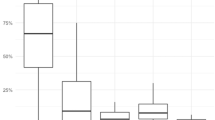Abstract
The distribution of PM2.5 and manganese (Mn) personal exposures was determined over a 4-month period in Indianapolis, IN, at a time when the gasoline additive, methylcyclopentadienyl manganese tricarbonyl (MMT), was not being used. The data collection period coincided with the data collection period in the Toronto, ON, study, where MMT had been used as a gasoline additive for over 20 years. The inferential or target population consisted of noninstitutionalized residents of the Indianapolis area during the monitoring period (from May 1996 through August 1996) who were at least 16 years old. The survey instruments used in this study (and also in Toronto) included a household screener form (HSF), a study questionnaire (SQ), and a time and activity questionnaire (TAQ). The SQ was administered to elicit information about the participant and his/her activities, occupation, and surroundings that might be relevant to his/her exposure to particles and Mn. In addition to the personal particulate matter (PM) and elemental 3-day monitoring, 240 participants completed a TAQ on a daily basis during the actual monitoring period. Also, a subset of participants had 3-day outdoor and indoor stationary monitoring at their home (approximately 58 observations), and sampling was conducted at a fixed site (approximately thirty-three 3-day observations). The quality of data was assessed and compared to the Toronto study in terms of linearity of measurement, instrument and method sensitivity, measurement biases, and measurement reproducibility. Twenty-six of the sample filters were subjected to two analyses to characterize the within-laboratory component of precision in terms of relative standard deviations (RSDs). The median RSD for Mn was 8.7%, as compared to 2.2% for Toronto. The quality assurance (QA) laboratory exhibited a clear positive bias relative to the primary laboratory for Al and Ca, but no systematic difference was evident for Mn. A high interlaboratory correlation (>0.99) was also attained for Mn. Mean field blank results for PM and Mn were 0.87 μg/m3 and 0.71 ng/m3, respectively, which were comparable to the Toronto study. The median RSDs for colocated fixed site and residential samples ranged from 2.2% to 9.0% for PM and from 8.8% to 15.3% for Mn, which were close to those observed in Toronto. For the PM10, the 90th percentile indoors was 124 μg/m3 compared with 54 μg/m3 outdoors. This pattern was even more pronounced for the PM2.5 data (90th percentiles of 92 μg/m3 indoors vs 30 μg/m3 outdoors). Personal PM2.5 was somewhat higher than the indoor levels, but the percentiles seemed to follow the more highly skewed pattern of the indoor distribution. This difference was largely due to the presence of some smokers in the sample; e.g., exclusion of smokers led to a personal exposure distribution that was more similar to the outdoor distribution. The estimated 90th percentile for the nonsmokers' personal exposures to PM was 43 μg/m3 compared with 84 μg/m3 for the overall population. In general, the Indianapolis PM levels of a given type and cut size were somewhat higher than the levels observed in Toronto, e.g., the median and 90th percentile for the personal PM2.5 exposures were 23 and 85 μg/m3, respectively, in Indianapolis, while in Toronto, the corresponding percentiles were 19 and 63 μg/m3. The cities' distributions of the proportion of the PM10 mass in the 2.5-μm fraction appeared similar for the residential outdoor data (medians of 0.67 and 0.65 for Indianapolis and Toronto, respectively, and 90th percentiles of 0.83 for both cities). For the indoor data, Indianapolis tended to have a larger portion of the mass in the fine fraction (median of 0.80 compared to 0.70 for Toronto). Unlike the PM, the Indianapolis indoor Mn concentration levels were substantially lower than the outdoor levels for both PM sizes, and the median personal levels for Mn in PM2.5 appeared to fall between the median indoor and outdoor levels. The personal Mn exposure distributions exhibited more skewness than the indoor or outdoor distributions (e.g., the means for the personal, indoor, and outdoor distributions were 7.5, 2.6, and 3.5 ng/m3, respectively, while the medians were 2.8, 2.2, and 3.2 ng/m3, respectively). At least a substantial portion of the high end of the personal exposure distribution appeared to be associated with occupational exposures to Mn. In general, the Mn levels in both cut sizes in Indianapolis were approximately 5 ng/m3 smaller than those in Toronto (e.g., the estimated median and mean levels for personal Mn exposures in PM2.5 were 2.8 and 7.5 ng/m3, respectively, in Indianapolis, but were 8.0 and 13.1 ng/m3 in Toronto). For the nonoccupational subgroups with no exposure to smoking and no subway riders in the two cities, the medians (2.6 ng/m3 in Indianapolis and 7.8 ng/m3 in Toronto) were similar to those for the overall populations, but the means were substantially smaller (3.1 ng/m3 in Indianapolis and 9.2 ng/m3 in Toronto). The median proportion of Mn in the fine fraction (relative to the PM10 Mn) for Indianapolis was 0.39 for outdoors and 0.55 for indoors; these ratios were somewhat smaller than the corresponding Toronto medians (0.52 and 0.73). The study found high correlations for particulates and Mn between personal exposures and indoor concentrations, and between outdoor and fixed site concentrations, and low correlations of personal and indoor levels with outdoor and fixed site levels. The pattern was similar to that observed for Toronto, but slightly more pronounced. The PM10 Mn concentrations (log scale) generally exhibited stronger associations among these various measures than the PM2.5 Mn concentrations. Comparisons of the particulate distributions between PTEAM (Riverside, CA) and the Indianapolis and Toronto studies were also made.
This is a preview of subscription content, access via your institution
Access options
Subscribe to this journal
Receive 6 print issues and online access
$259.00 per year
only $43.17 per issue
Buy this article
- Purchase on Springer Link
- Instant access to full article PDF
Prices may be subject to local taxes which are calculated during checkout








Similar content being viewed by others
Notes
US Environmental Protection Agency (EPA). Information Needed to Improve The Risk Characterization of Manganese Tetraoxide (Mn3O4) and Methylcyclopentadienyl Manganese Tricarbonyl (MMT). Office of Research and Development (ORD), 1991.
Abbreviations
- DEC_LIM:
-
decision limit
- FPR:
-
false-positive (error) rate
- FNR:
-
false-negative (error) rate
- HEPA:
-
high-efficiency particulate air
- HHs:
-
households
- HSF:
-
household screener form
- IDL:
-
instrument detection limit
- MDL:
-
method detection limit
- MMT:
-
methylcyclopentadienyl manganese tricarbonyl
- NONOCC:
-
nonoccupational
- PM 2.5:
-
particulate matter with 50% upper cut-point of 2.5 μm
- PM10:
-
particulate matter with 50% upper cut-point of 10 μm
- PTEAM:
-
Particulate Total Exposure Assessment Methodology
- QA:
-
quality assurance
- QC:
-
quality control
- RSD:
-
relative standard deviation
- SAS:
-
Statistical Analysis Software
- SQ:
-
study questionnaire
- SUDAAN:
-
survey data analysis
- TAQ:
-
time and activity questionnaire
- US EPA:
-
US Environmental Protection Agency
References
Clayton, CA, Hines, JW, and Elkins, PD . Detection limits with specified assurance probabilities. Anal Chem (1987) 59: 2506–2514
Clayton, CA, Perritt, RL, Pellizzari, ED, Thomas, KW, Whitmore, RW, Wallace, LA, Ozkaynak, H, and Spengler, JD . Particle Total Exposure Assessment Methodology (PTEAM) Study: Distributions of particulate matter and elemental concentrations in personal, indoor, and outdoor air samples in a Southern California community. J Expos Anal Environ Epidemiol (1993) 3(2)227–250
Clayton, CA, Pellizzari, ED, Rodes, CE, Mason, RE, and Piper, LL . Estimating distributions of long-term particulate matter and manganese exposures for residents of Toronto, Canada. Atmos Environ (1999) 33: 2515–2526
Crump, KS . Manganese3 exposures in Toronto during use of the gasoline additive, methylcyclopentadienyl manganese tricarbonyl. J Expos Anal Environ Epidemiol (2000) 10(3)227–239
Ozkaynak, H, Xue, J, Spengler, J, Wallace, L, Pellizzari, E, and Jenkins, P . Personal exposure to airborne particles and metals: Results from the particle team study in Riverside, California. J Expos Anal Environ Epidemiol (1996) 6(1)57.R
Pellizzari, ED, Clayton, CA, Rodes, CE, Mason, RE, Piper, LL, Fort, B, Pfeifer, G, and Lynam, D . Particulate matter and manganese exposures in Toronto, Canada. Atmos Environ (1999) 33: 721–734
Rodes, C, Kamens, R, and Wiener, R . The Significance and Characteristics of the Personal Activity Cloud on Exposure Assessments for Indoor Contaminants, Indoor Air Vol. 2 Munksgaard Intl. Publishers, Copenhagen, Denmark 1991 pp. 123–145
Rodes, C, Lawless, P, Evans, G, Sheldon, L, Williams, R, Vette, A, and Creason, J . The relationships between personal PM exposures for elderly populations and indoor and outdoor concentrations for three retirement center scenarios. J Expos Anal Environ Epidemiol, January 2000 submitted for publication
Thomas, KW, Pellizzari, ED, Clayton, CA, Whitaker, DA, Shores, RC, Spengler, J, Ozkaynak, H, Froehlich, SK, and Wallace, LA . Particle Total Exposure Assessment Methodology (PTEAM) 1990 study: Method performance and data quality for personal, indoor, and outdoor monitoring. J Expos Anal Environ Epidemiol (1993) 3(2)203–226
Acknowledgements
This research study was sponsored by Ethyl (Richmond, VA). The authors are grateful to the sponsor, to the many technicians and research personnel involved in carrying out the study, and to the residents of Indianapolis and Toronto who participated in the study.
Author information
Authors and Affiliations
Corresponding author
Rights and permissions
About this article
Cite this article
PELLIZZARI, E., CLAYTON, C., RODES, C. et al. Particulate matter and manganese exposures in Indianapolis, Indiana. J Expo Sci Environ Epidemiol 11, 423–440 (2001). https://doi.org/10.1038/sj.jea.7500186
Received:
Published:
Issue Date:
DOI: https://doi.org/10.1038/sj.jea.7500186
Keywords
This article is cited by
-
Opportunities for evaluating chemical exposures and child health in the United States: the Environmental influences on Child Health Outcomes (ECHO) Program
Journal of Exposure Science & Environmental Epidemiology (2020)
-
Modeling and estimating manganese concentrations in rural households in the mining district of Molango, Mexico
Environmental Monitoring and Assessment (2015)
-
Residential indoor and personal PM10 exposures of ambient origin based on chemical components
Journal of Exposure Science & Environmental Epidemiology (2014)
-
Reduced Atmospheric Manganese in Montreal Following Removal of Methylcyclopentadienyl Manganese Tricarbonyl (MMT)
Water, Air, & Soil Pollution (2011)
-
Indoor Environmental Differences between Inner City and Suburban Homes of Children with Asthma
Journal of Urban Health (2007)



